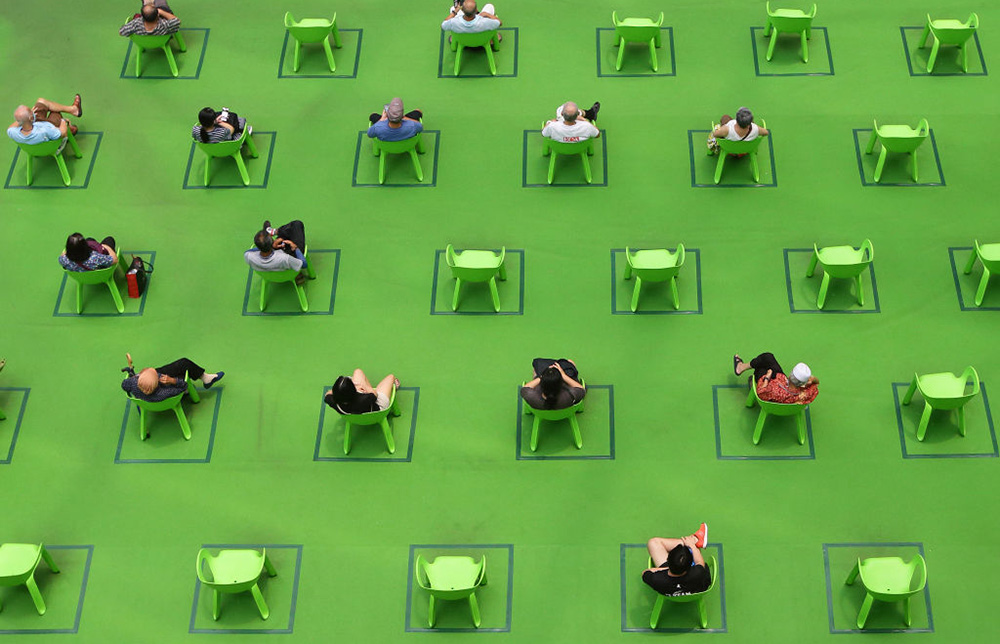新加坡发布疫情应对手册,助力银行业者重返办公室

随着新加坡为后疫情时代的办公生活做准备,不那么拥挤的交易大厅、人脸识别系统和分区工作都可能会成为当地银行业者的新工作常态。
根据新加坡银行业协会和新加坡金融管理局(Monetary Authority of Singapore)于3月23日发布的委托研究建议,职员在新冠疫情后重返办公岗位后,市内金融机构应当更多地使用免接触式技术,为每位职员留出更多的办公空间,并让职员在交易大厅分开办公。
据报道,银行机构还被鼓励采用办公桌轮用制,部署运动检测器,实行体温和口罩检测筛查,改善通风条件,以避免潜在感染。报道称,除了总部以外,机构也应该允许工作人员在卫星办公室或分支机构工作。
研究指出,采取这些措施的时候,“必须既要确保工作场所的安全,也要尽量减少对业务运营的干扰”。这项研究是由房地产咨询公司戴德梁行(Cushman & Wakefield Plc)和新加坡的一些大型银行共同开展的。
新加坡市有200多家金融机构,与其他全球银行业中心一样,它也在研究如何让在家工作生活一年多的员工重返办公室。尽管感染率一直不高,但该城邦国家还是谨慎对待让职员重返办公室一事。
华尔街也在公布未来几个月让更多银行业者重返工作岗位的计划。与此同时,在上海去年有效控制住疫情,成为全球首个重新开放的主要金融中心以后,当地银行业从业人员已重返办公室多月。
新加坡的最新建议所设想的工作环境,可以迅速切换到“疫情爆发”模式,使企业能够及时对未来潜在的疫情作出反应。
“新加坡金融管理局鼓励金融机构考虑采用应对手册中的策略建议,以便加强其工作场所的安全性和应变能力。”新加坡金融管理局的副局长王宗智在一份声明中表示,“这会有助于我们为未来出现可能需要人员保持安全距离和安排在家办公的情况做好准备。”
报道还拿新加坡的疫情管控措施与香港、上海、伦敦、纽约和悉尼等其他主要金融中心进行了比较,发现其办公室的密度与悉尼相当,平均每个座位80至120平方英尺,比香港40到100平方英尺的密度宽敞。
金融机构适应后疫情时代的方式,可能会改变世界各地金融中心的商圈面貌。已经有一些跨国银行表示,随着工作方式变得更加灵活,它们将能够大幅减少办公室面积。
汇丰控股(HSBC Holdings Plc)预计,长期来看,其办公面积将减少40%。劳埃德银行集团(Lloyds Banking Group)也预计,到2023年其办公空间将减少20%。其他金融机构则对这一想法不太感兴趣,高盛集团(Goldman Sachs Group)的首席执行官苏德巍(David Solomon)称,远程工作是“一种非常规现象,我们将尽快纠正”。
在新加坡,星展集团控股有限公司(DBS Group Holdings Ltd.)允许所有员工最多有40%的时间远程工作,也开始采取频繁进行空气净化等预防措施。新加坡大华银行(United Overseas Bank Ltd.)也计划在疫情限制措施解除后允许其2.6万名员工中约65%的人每周远程工作两天。(财富中文网)
译者:万志文
随着新加坡为后疫情时代的办公生活做准备,不那么拥挤的交易大厅、人脸识别系统和分区工作都可能会成为当地银行业者的新工作常态。
根据新加坡银行业协会和新加坡金融管理局(Monetary Authority of Singapore)于3月23日发布的委托研究建议,职员在新冠疫情后重返办公岗位后,市内金融机构应当更多地使用免接触式技术,为每位职员留出更多的办公空间,并让职员在交易大厅分开办公。
据报道,银行机构还被鼓励采用办公桌轮用制,部署运动检测器,实行体温和口罩检测筛查,改善通风条件,以避免潜在感染。报道称,除了总部以外,机构也应该允许工作人员在卫星办公室或分支机构工作。
研究指出,采取这些措施的时候,“必须既要确保工作场所的安全,也要尽量减少对业务运营的干扰”。这项研究是由房地产咨询公司戴德梁行(Cushman & Wakefield Plc)和新加坡的一些大型银行共同开展的。
新加坡市有200多家金融机构,与其他全球银行业中心一样,它也在研究如何让在家工作生活一年多的员工重返办公室。尽管感染率一直不高,但该城邦国家还是谨慎对待让职员重返办公室一事。
华尔街也在公布未来几个月让更多银行业者重返工作岗位的计划。与此同时,在上海去年有效控制住疫情,成为全球首个重新开放的主要金融中心以后,当地银行业从业人员已重返办公室多月。
新加坡的最新建议所设想的工作环境,可以迅速切换到“疫情爆发”模式,使企业能够及时对未来潜在的疫情作出反应。
“新加坡金融管理局鼓励金融机构考虑采用应对手册中的策略建议,以便加强其工作场所的安全性和应变能力。”新加坡金融管理局的副局长王宗智在一份声明中表示,“这会有助于我们为未来出现可能需要人员保持安全距离和安排在家办公的情况做好准备。”
报道还拿新加坡的疫情管控措施与香港、上海、伦敦、纽约和悉尼等其他主要金融中心进行了比较,发现其办公室的密度与悉尼相当,平均每个座位80至120平方英尺,比香港40到100平方英尺的密度宽敞。
金融机构适应后疫情时代的方式,可能会改变世界各地金融中心的商圈面貌。已经有一些跨国银行表示,随着工作方式变得更加灵活,它们将能够大幅减少办公室面积。
汇丰控股(HSBC Holdings Plc)预计,长期来看,其办公面积将减少40%。劳埃德银行集团(Lloyds Banking Group)也预计,到2023年其办公空间将减少20%。其他金融机构则对这一想法不太感兴趣,高盛集团(Goldman Sachs Group)的首席执行官苏德巍(David Solomon)称,远程工作是“一种非常规现象,我们将尽快纠正”。
在新加坡,星展集团控股有限公司(DBS Group Holdings Ltd.)允许所有员工最多有40%的时间远程工作,也开始采取频繁进行空气净化等预防措施。新加坡大华银行(United Overseas Bank Ltd.)也计划在疫情限制措施解除后允许其2.6万名员工中约65%的人每周远程工作两天。(财富中文网)
译者:万志文
Less-crowded trading floors, facial recognition systems and split work areas could all become routine for bankers in Singapore as the Southeast Asian financial hub readies for office life in a post-COVID world.
Financial institutions in the city should use more no-touch technology, allow more space for each employee and adopt split teams on trading floors once staff return after the pandemic, according to recommendations from a study commissioned by the city’s banking association and the Monetary Authority of Singapore that was published on March 23.
Lenders are also being encouraged to use hot-desking, motion detectors, temperature and face-mask detection screening and improved ventilation to avoid potential contamination, according to the report. Staff should be allowed to work from satellite offices or branches in addition to the main headquarters, it said.
Such measures “are imperative to strike a balance between workplace safety and minimizing disruption to business operations,” said the study, which was carried out by real estate consultancy Cushman & Wakefield Plc and some of Singapore’s biggest banks.
With more than 200 financial institutions operating in Singapore, the city is among global banking centers looking at how to get staff back to the office after they’ve spent more than a year juggling working from home and family life. The city-state has taken a cautious approach to returning staff to offices even as infection rates remain low.
Wall Street has also been unveiling plans to bring more bankers back in the coming months, while employees in Shanghai have been back in the office for months after the Chinese city was the world’s first major center to reopen last year after taming the virus.
The latest recommendations from Singapore envision a workplace that’s geared to switch quickly to a ‘pandemic-on’ mode so that companies can react to future pandemics.
“MAS encourages our financial institutions to consider the recommended strategies in the Playbook to enhance safety and resiliency in the workplace,” MAS deputy managing director Ong Chong Tee said in a statement. “This will be helpful to be well prepared for any situations in future that may require safe distancing and work-from-home arrangements.”
The report also compares Singapore’s approach in managing the pandemic with other major financial hubs like Hong Kong, Shanghai, London, New York and Sydney. It found that the density of its offices is comparable to Sydney, with an average 80 to 120 square feet per seat. That’s more spacious than Hong Kong, where it’s 40 to 100 square feet.
How financial institutions adapt to a post-Covid world has the potential to reshape business districts in hubs around the world. Already some global banks have said that an embrace of more flexible working will allow them to significantly reduce their property footprint.
HSBC Holdings Plc is predicting a 40% reduction in its property footprint over the long term and Lloyds Banking Group Plc is projecting a 20% cut in office space by 2023. Others are less excited about the idea with David Solomon, chief executive officer of Goldman Sachs Group Inc. calling remote work “an aberration that we are going to correct as quickly as possible.”
In Singapore, DBS Group Holdings Ltd. is allowing all staff to work up to 40% of their time remotely and has started precautionary measures such as frequent air purging. United Overseas Bank Ltd. will allow about 65% of its 26,000-strong workforce to work remotely two days a week once COVID-19 restrictions are lifted.













